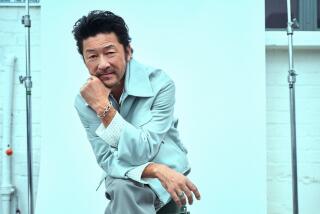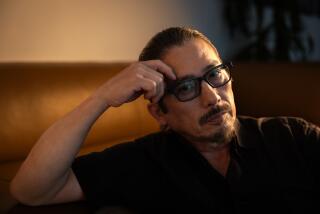Interview: The man behind ‘Naruto’
- Share via
At 34, Masashi Kishimoto is one of the most successful manga-ka, or manga artists, in the world. His long-running series about ninja-in-training Naruto Uzumaki has sold tens of millions of books around the world. Kishimoto, born in the rural prefecture of Okayama, lives in Tokyo, where he works with several assistants. Although Naruto can be insufferably cocky at times, Kishimoto seems a bit overwhelmed by the runaway success of his first major creation.
“It’s rather awkward to talk about what makes Naruto appealing to audiences, but I think his being a knucklehead gives him an appeal,” Kishimoto said in an interview conducted via e-mail with help from translator Hiromi Psaila. “Perfect heroes are cool, but no one can really empathize or identify with them. Naruto often makes blunders, and he has weaknesses. Naruto feels inferior to his peers, but he hates to be a loser. Although he doesn’t think about it too much, he knows he hates to lose, and we all know what that feels like. I think readers see themselves in Naruto, and that’s what appeals to them: They can empathize with him and his weaknesses.”
As a boy, Kishimoto was obsessed with manga and baseball. In elementary school, he became “completely addicted” to the popular boys’ series “Dragon Ball.” His interest gradually expanded to include other manga series, notably Katsuhiro Otomo’s landmark “Akira.” Kishimoto explained that he was so focused on his drawings that he did poorly in high school, ranking 30th in a class of 31.
While in art school, Kishimoto won a contest for aspiring manga artists with his story “Karakuri” (Mechanism). His next work, a manga short story about a fox spirit disguised as a human (foxes are traditional shape-shifters in Japanese folklore) named Naruto, appeared in 1997. Two years later, a new version of “Naruto” premiered as a serial in the magazine Weekly Shonen Jump and scored an immediate hit.
Although the name was the same, the new version of “Naruto” was very different from the previous story. The Hidden Leaf Village of ninjas was nearly destroyed by a nine-tailed fox demon, a creature so terrible it was seen as divine punishment. The village chieftain died, sealing that demon within the body of a newborn baby: Naruto. Because he was associated with the demon, Naruto was a lonely child, shunned by the people of the village. At the Ninja Academy, he blew off his lessons, played pranks and got into mischief.
“When Naruto was born, it was more like he somehow came out, rather than my creating him from some inspiration,” he continued. “The only image I had in mind was a character who was a naughty boy. I was a poor student, but unlike Naruto, I was the type of poor student who gave up easily and pondered things that weren’t worth pondering. I wanted Naruto to be different. He was created based on my self-image of my own childhood, but different from how I really was.”
His impish nature and spotty record make Naruto a come-from-behind kid. After graduating from the academy -- after three tries -- he begins his advanced training as a ninja. Although he remains a goof-off at heart, Naruto will lay his life on the line to protect his friends. And in extreme circumstances, he can draw on the energy of the demon imprisoned within his body. Under the supervision of his teacher, Kakashi, he goes on missions in a team with his rival Sasuke and Sakura, on whom he nurtures a crush.
Kishimoto’s strong clean lines and massed areas of black give the many action sequences a visual punch. The human figures are well-drawn and accurately proportioned, and their poses suggest believable movements. “I chose to draw the human figures as accurately as possible because I thought it would give a more realistic feel to the action scenes,” Kishimoto explains. “Exaggeration can lend action scenes more force, but I like to stick to more realistic figures: They help keep the cool in the action scenes, although they may be not as forceful as the exaggerated ones.”
Kishimoto lays out each page like a director/cinematographer, often juxtaposing a series of close-ups of a character’s changing expression with large drawings of a combat sequence. The viewer sees Naruto’s resolve stiffen before he kicks the wasabi out of his opponent.
“I watch a lot of movies, and I tend to be influenced by scenes that intrigue me, that make me want to use the same effects or technique,” Kishimoto explains. “I once adopted [actor-director] Takeshi Kitano’s technique of shooting objects from a great distance to stifle the emotion in the scene. I like the way Quentin Tarantino creates a scene using a series of close-ups or showing very cool images of a person or people walking on some ordinary street in slow motion. I wish I could achieve that kind of slow-motion effect in manga, but it’s rather difficult to draw; the only things we can play with are tones of black and white. I also like Michael Bay’s technique of shooting a scene against the background light. I’d like to try this in manga, but again it would be rather difficult.”
While still a student, Kishimoto studied the work of some of the most famous manga artists and Japanese animators. In addition to “Dragon Ball” and “Akira,” he read, re-read and copied the drawings in Hiroyuki Okiura’s sci-fi fantasy “Jin-Roh: The Wolf Brigade,” Koji Kiriyama’s ninja tale “Ninku” and Masamune Shirow’s groundbreaking cyberpunk tale “Ghost in the Shell,” which was adapted to the screen by Mamoru Oshii. Kishimoto feels their successes paved by the way for the international popularity of “Naruto,” which was influenced by them.
“I didn’t think much about foreign readers when I began ‘Naruto,’ but I knew that many of the artists who influenced me had already been accepted overseas,” he concluded. “All the people I was influenced by have been very successful in other countries, which may be why it was easier for my work to be accepted there. ‘Naruto’ owes a lot to those artists who won acceptance and popularity overseas.”
Solomon is the author, most recently, of “Disney Lost and Found.”
More to Read
The biggest entertainment stories
Get our big stories about Hollywood, film, television, music, arts, culture and more right in your inbox as soon as they publish.
You may occasionally receive promotional content from the Los Angeles Times.










